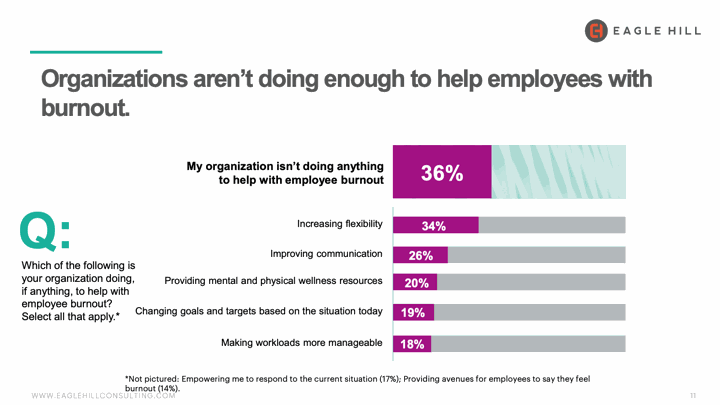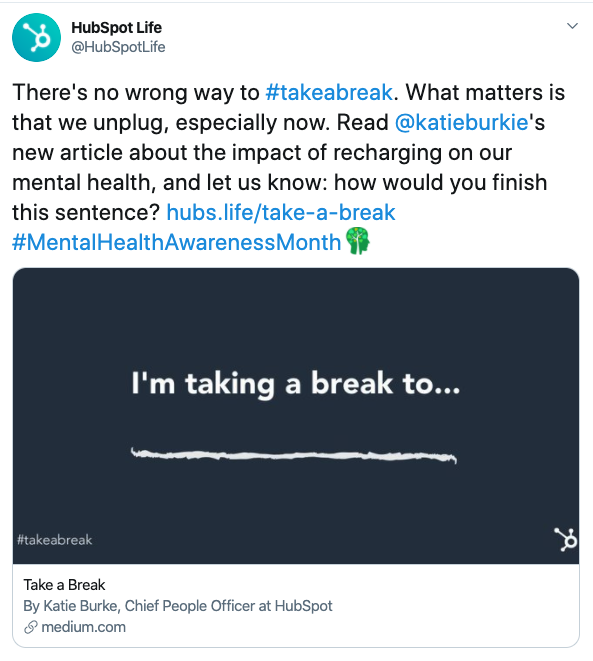A recent report from Eagle Hill Consulting found that a staggering 45% of US employees are feeling burnout, with 25%feeling burnout due to the novel coronavirus.
Because burnout has become more prevalent in recent years the World Health Organization (WHO) has recently classified it as an occupational phenomenon and labeled it a symptom of chronic stress at work. With the addition of the global pandemic the stress surrounding our health, careers, social lives, financial situations, economic prosperity, and basic needs are magnified. We’ve reached the next stage of this pandemic: burnout.
And while our first inclination as people leaders is to say that we're doing everything we can to help, it might be worth it to revisit this.
The same report from above found that 36% of employees said their organization isn't doing anything to help with employee burnout.

Now is your opportunity to brainstorm far and wide, and use this unique moment in time to pull out all stops to support the heart of your company: your people.
When left unacknowledged and unaddressed stress turns to burnout and burnout turns to tangible physical, mental, emotional, social, and financial implications on the lives of your people.
“An ounce of prevention is better than a pound of cure”, but wherever your organization or your people are, here are 11 ideas to help you support your people in avoiding burnout.
1. Develop new communication policies.
Right now, people need transparency from leadership. Make sure you're keeping them abreast of all changes and in a timely, easy-to-digest way.
This can be a new “Weekly Video from Management” or a monthly update on your internal wiki from upper management. People are grasping for information, and when it’s not provided to them, they’re left to fill in the blanks themselves -- often incorrectly
2. Empower your managers to lead with empathy
According to the Mayo Clinic burnout is "emotional exhaustion" that can come from a variety of factors including a lack of control at work, unclear expectations, dysfunctional work environments, lack of social support and a poor work-life balance.
Help team leads and managers to support their people in preventing burnout by getting them to set realistic expectations for projects and deadlines, create clear work and personal life boundaries, and encourage their team to take time off.
If you need an effective way to get this message across to your team leaders, consider pulling it together into an infographic or a one-pager that is easy-to-digest and act upon. You can also keep your eyes and ears to the ground and recognize the managers who are making this a priority, like it should be.
3. Find ways to create certainty
Everything is uncertain, and so this one might be difficult. However, some ways organizations are creating certainty are by announcing that their remote work options will be able to continue forever. Twitter, Square, Facebook are just a few who have come out in support of WFH.
Also, this WFH stuff is very, very present in your peoples' minds.
Here's what a recent Dice piece had to say on burnout:
In a recent survey from Blind, some 90 percent of respondents said they expected a flexible work-from-home policy to persist well after COVID-19 is finally contained. “If professionals are already demonstrating behavioral changes, employers should value these insights and begin to adapt to these expectations now,” read Blind’s accompanying blog posting. “How a company reacts today and the policies implemented in the near future will impact on what talent pool they have access to in the future.”
4. Institute new mental health policies.
Consider creating a COVID-related sick policy where people can get an extra personal day or two which they are required to take. This will let your people know just how important their mental health is to you. You can also create a policy where people introduce more "break time" or "relax time" into their day.
5. Create a culture that supports psychological safety.
Psychological safety refers to an individual's ability to express their thoughts, ideas, concerns, or mistakes without fear of negative consequences.
When people feel safe, they feel like they can be their true selves which leads to greater control and certainty.
6. Create an initiative to focus on what's staying the same.
It's easy for people to hear about changes happening in an organization and wonder how they're going to impact them personally.
If you find people stiff-arming your changes, do what this HBR article suggests, and get people to focus on what's staying the same. By doing this, you can get people to welcome your changes with open arms.
7. Find ways to double down on small wins.
When everything around us seems like it's going wrong, it's easy to turn that temporary mindset into a permanent character trait. Build optimism and a focus on progress by creating a program (Slack Channel, a recognition program, a new section on your monthly company-wide emails) that emphasizes all wins, no matter the size.
8. Launch a Summer Friday program.
A program that every employee secretly wants their company to adopt. If you’ve been thinking about this or feel like your people need more approval and encouragement to take a break -- this might be perfect for you.
You can give people every summer Friday off, or just half days, or you can focus it down to one month. Regardless of where you land, your people will love the forced time off.

9. Give your team greater access to meditation.
We harp a lot on meditation. The data is plentiful in support that a meditation practice can have an immense impact on the lives of your people.
It's easy for us to get swept away in the anxiety of the unknown, especially right now. It's important to acknowledge anxiety, but the trick is to not get carried away by it. Experts suggest a powerful trick to avoid drowning in the anxiety of the future is to ground yourself in the present. Allow yourself a few deep breaths, feel your feet on the ground, your butt in your seat, and see what else you can acknowledge happening to you physically in this very moment. This is just one reason meditation is so powerful.
In 2017, 14.2% of US adults said that they’d meditated in the past 12 months. It's likely that these numbers are much higher now, they're still fairly low considering the positive benefits. Why is it not 100%?
Create a positive habit around meditation by starting a meditation program. You can bring in meditation experts or coaches to lead daily or weekly meditations, or by offering stipends to use toward their own apps.
10. Encourage people to own their health needs.
While it's important as organizational leaders that we keep a pulse on the health of our people and our organization, it's impossible to know everything that's happening. It's also unfair to expect that every single person's mental health falls on you -- empower people to take charge of their mental health by creating policies around how they can exercise their needs and take care of themselves in a way that the organization supports.
HubSpot recently did a fantastic job at this by encouraging their people to take a break, take it loudly, and to even share their reason why they're taking a break.

11. Take time off yourself
Too often people operations leaders are too busy taking care of others, we forget to put our emergency mask on first. Set the tone for your organization by taking a necessary break, even if you have nowhere to go.
Deepen your learning:
- 5 Statistics on How Covid Changed the Workplace, For Better or Worse
- 15 Thoughtful Ways Companies Can Support Parents Working From Home
- 5 Employee Engagement Trends HR Leaders Need to Stay Ahead of in 2021
Compt is the #1 employee stipends platform that gives your people the freedom to choose the lifestyle perks that are best for them and their always evolving needs, even when remote. Interested in learning how Compt might benefit your company? Consult with our team or request a demo.
